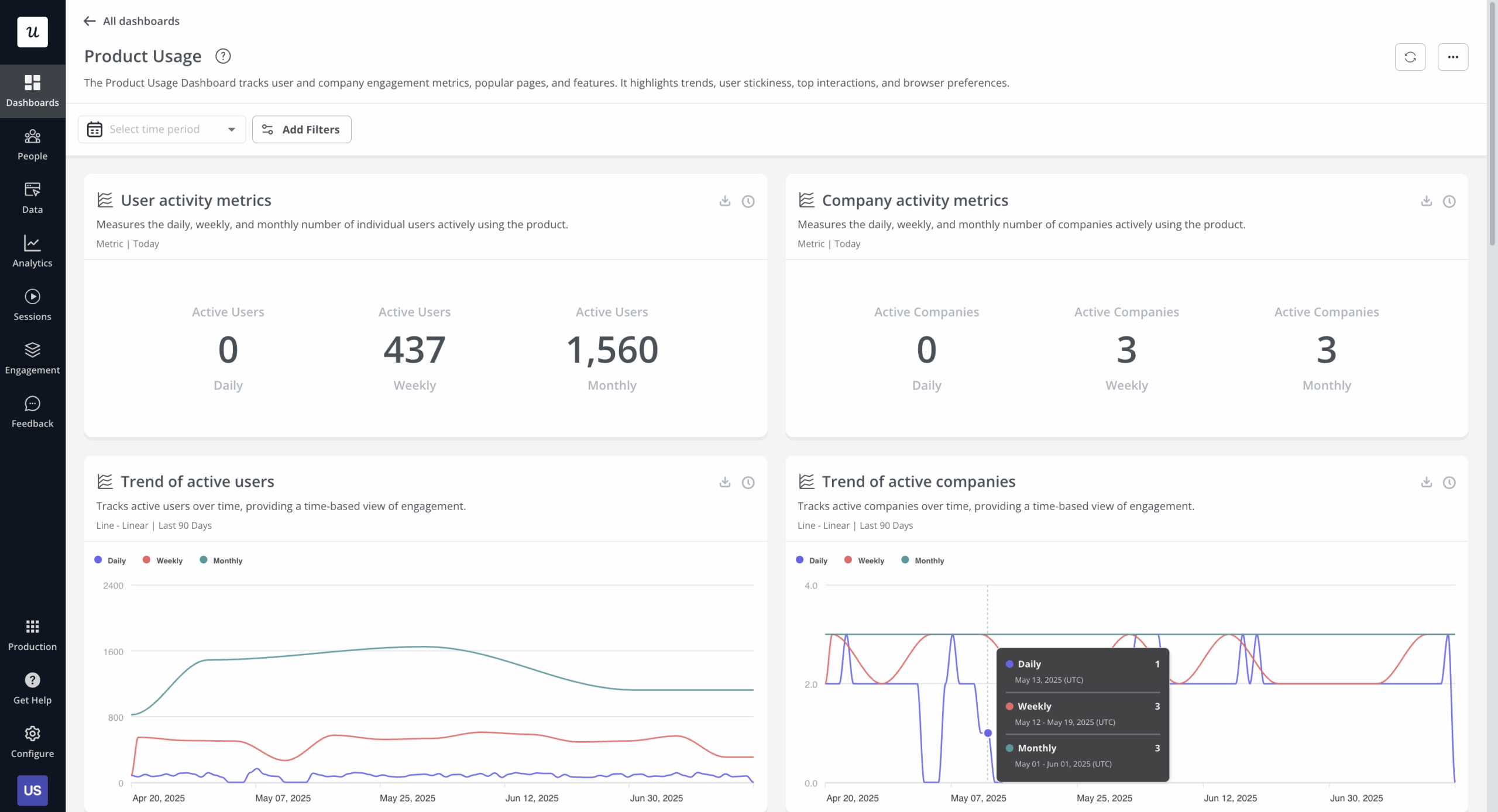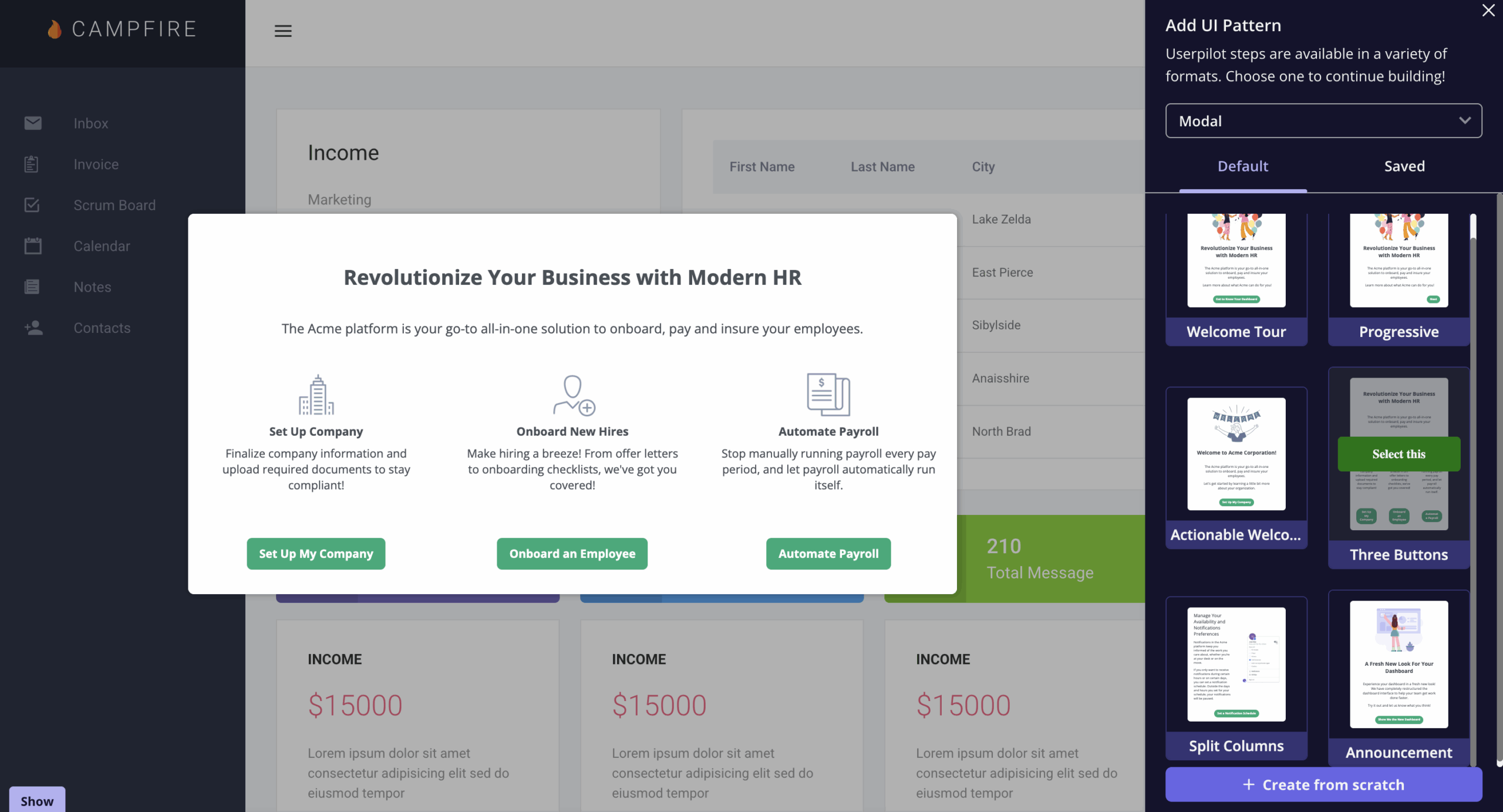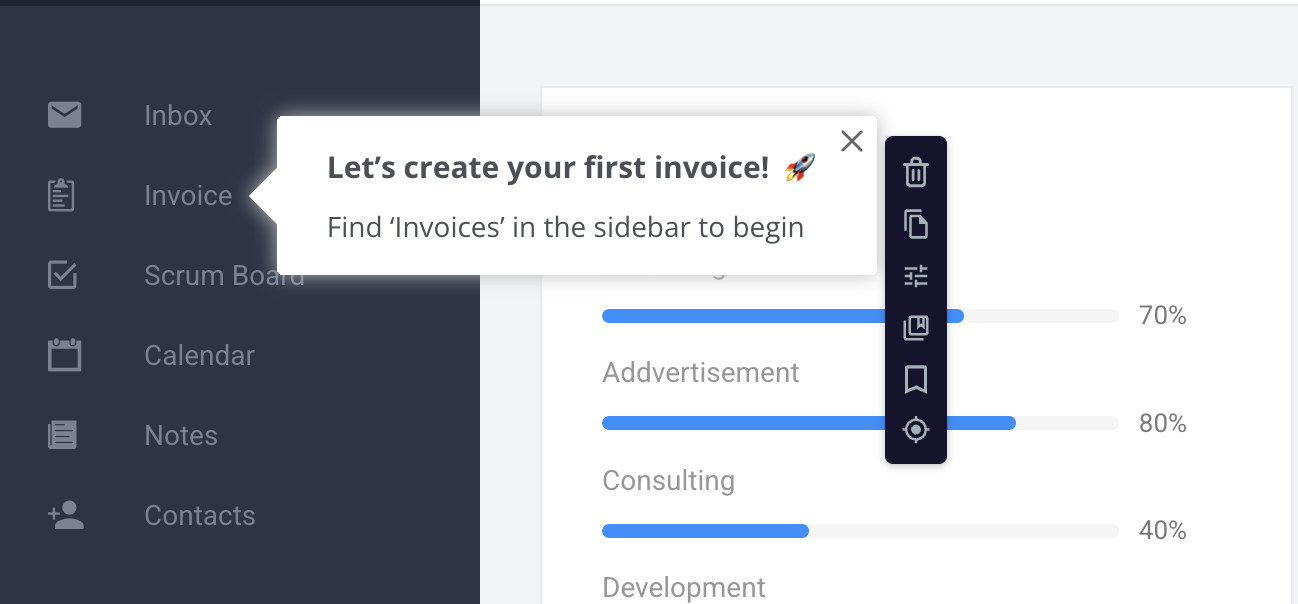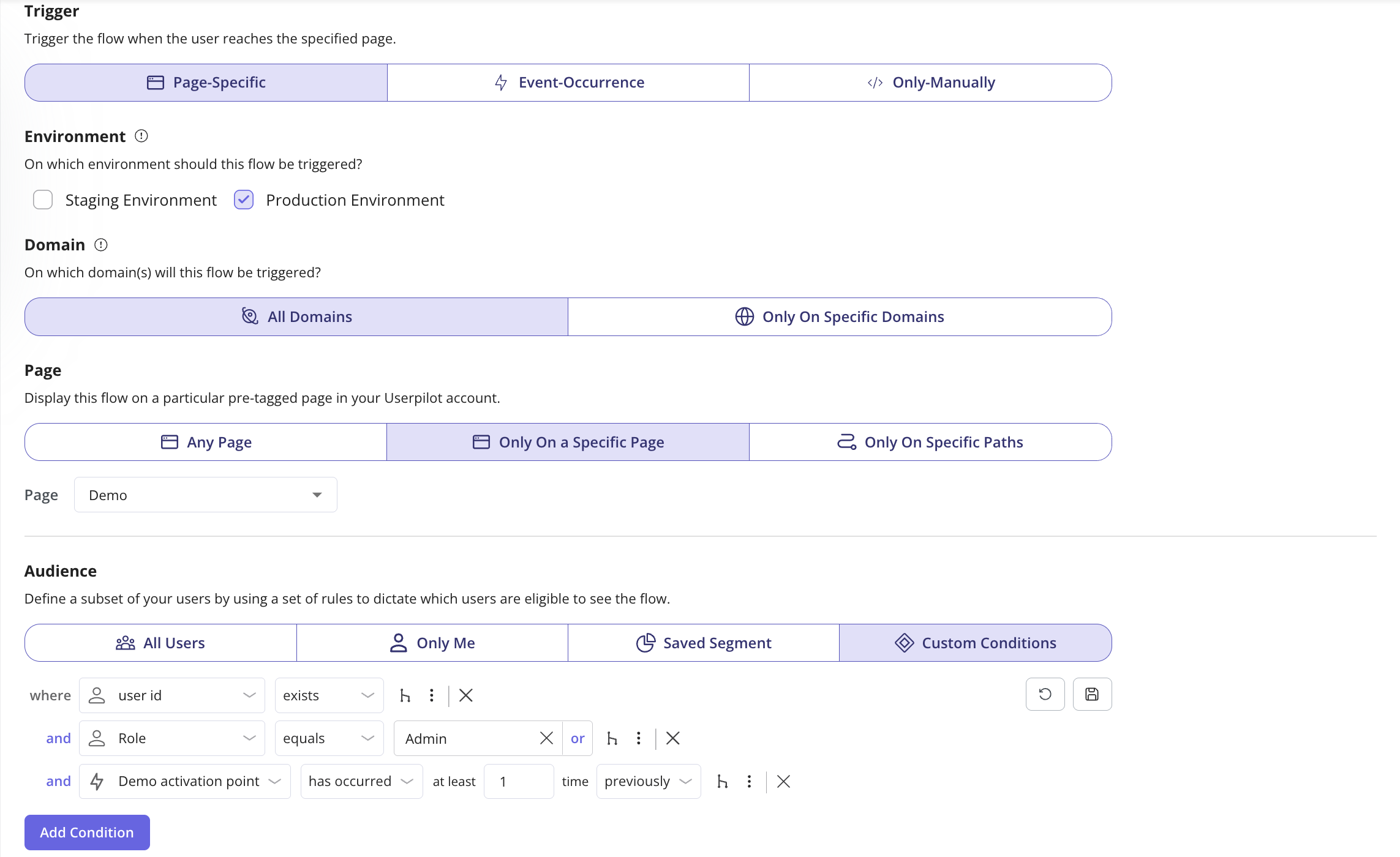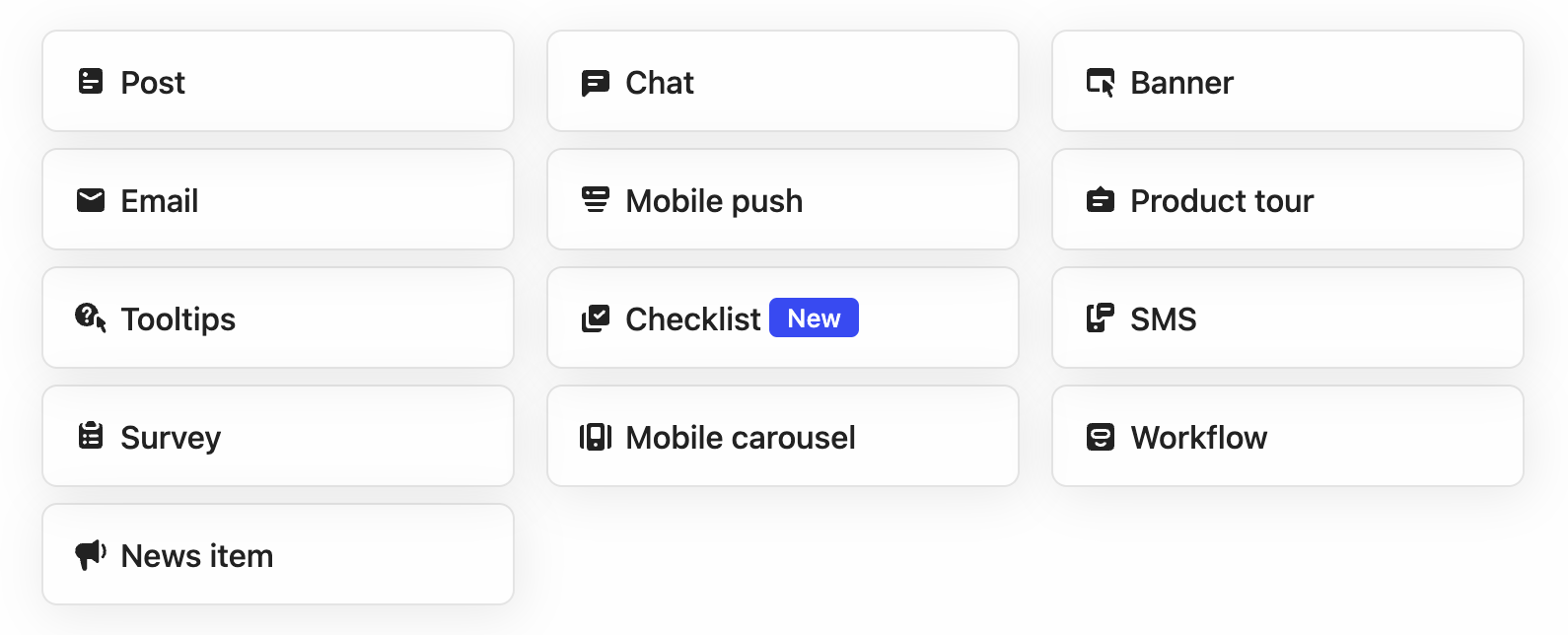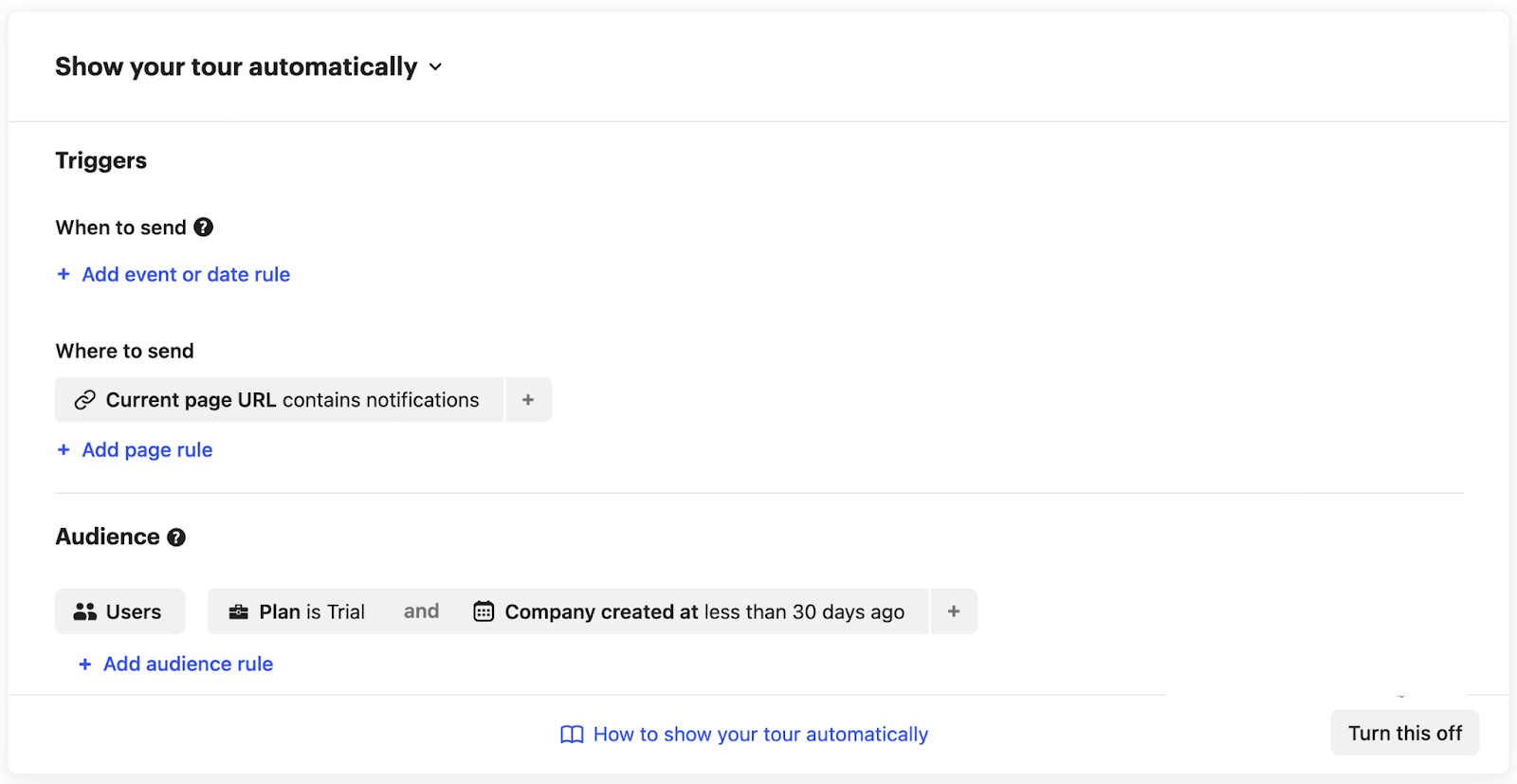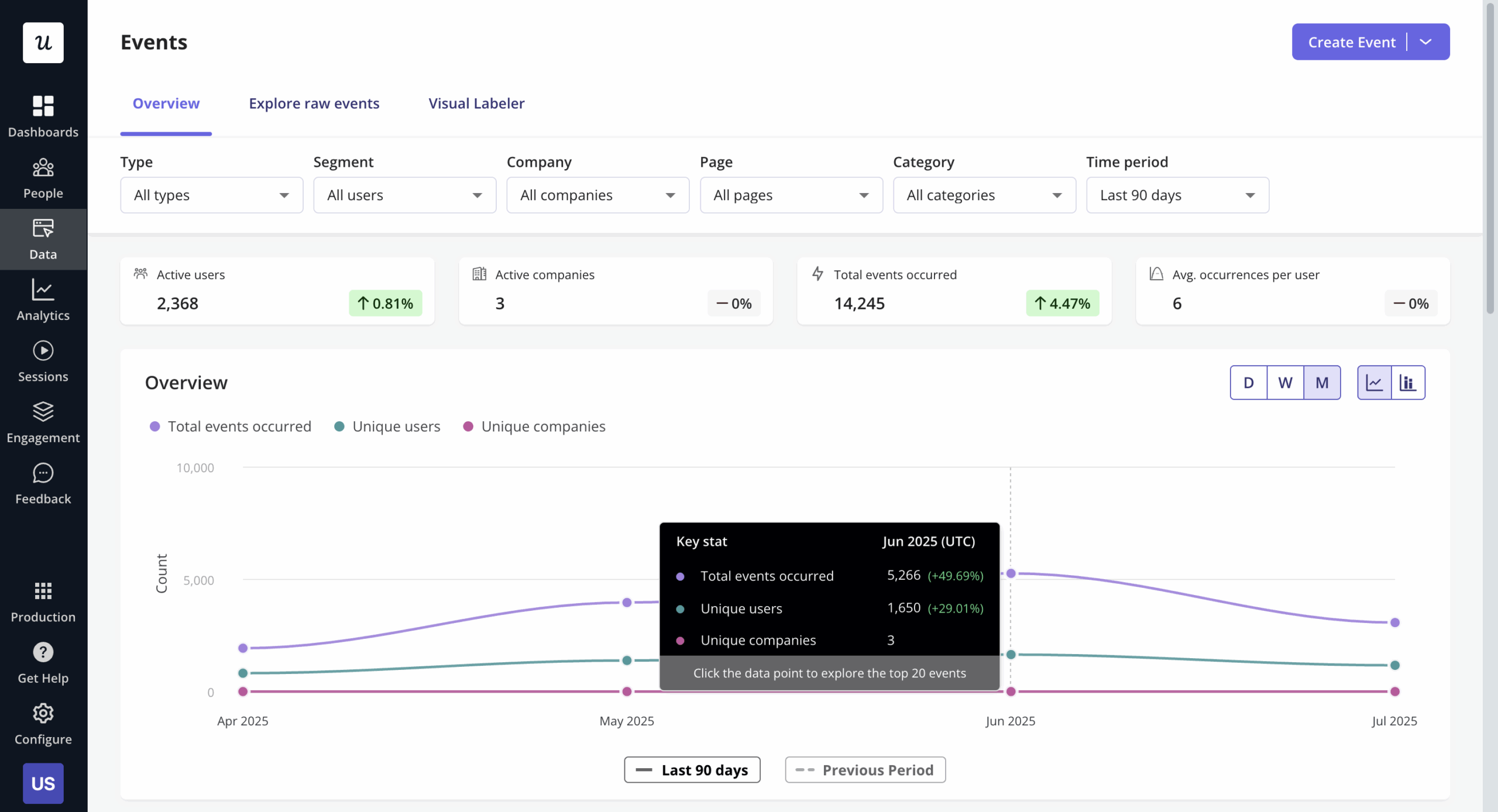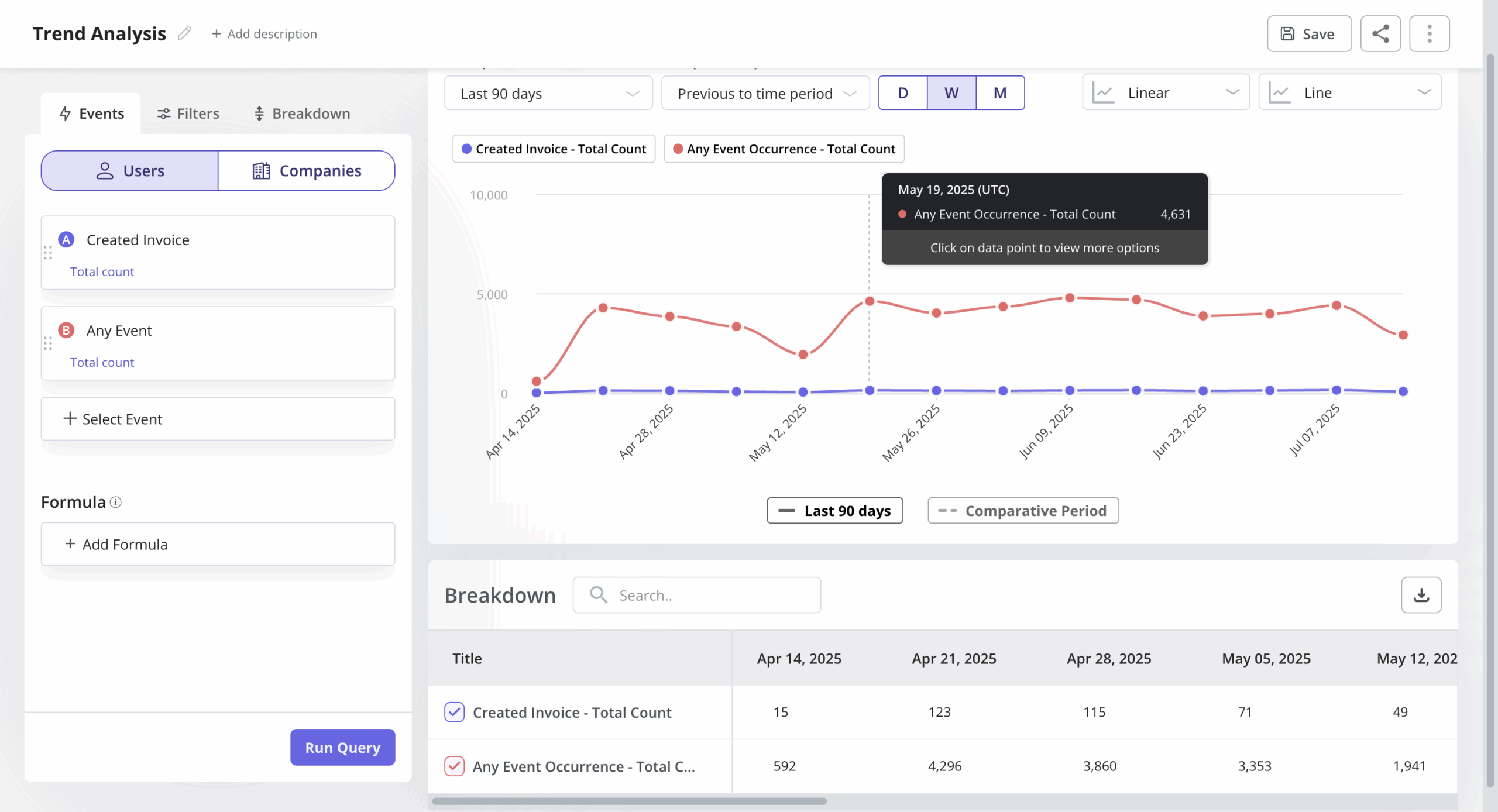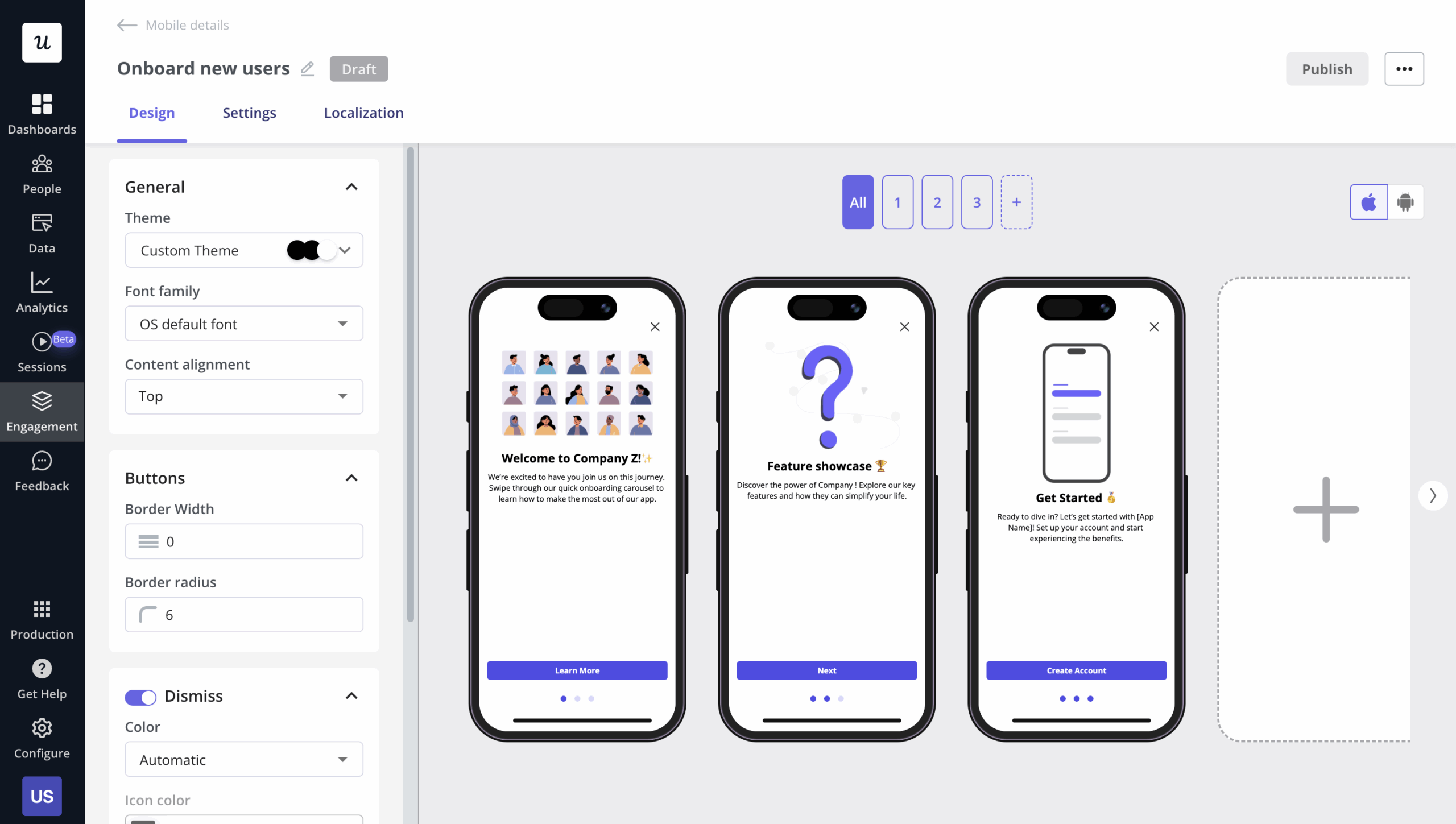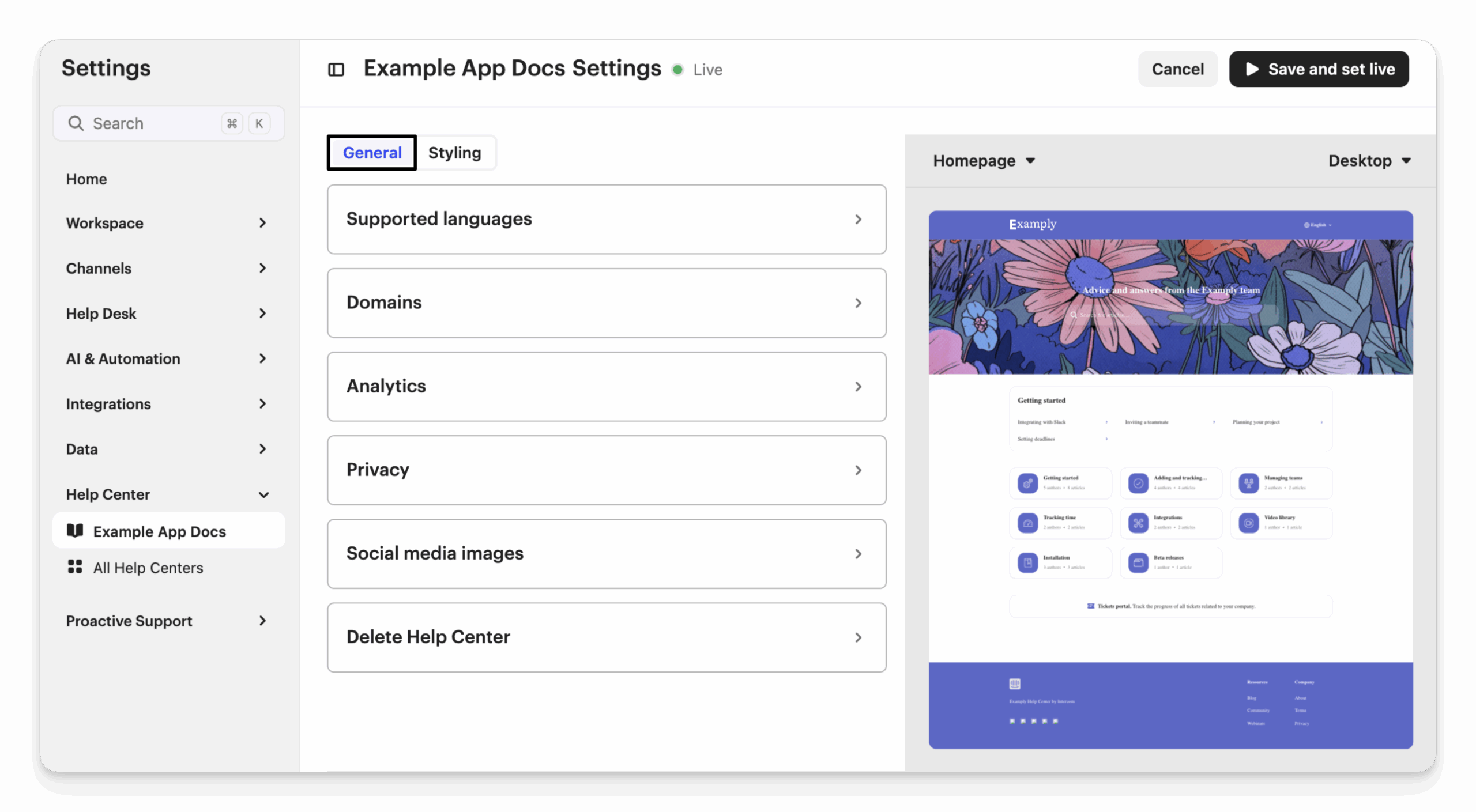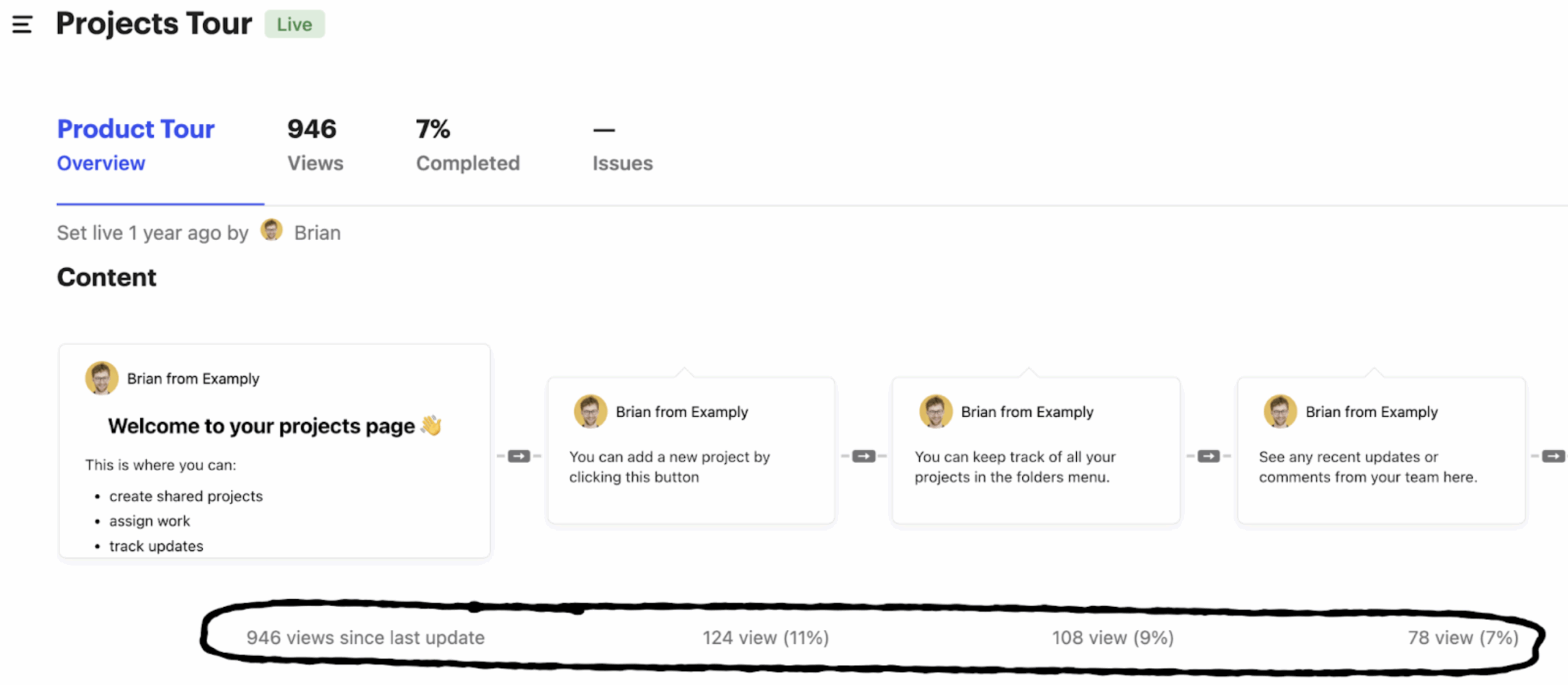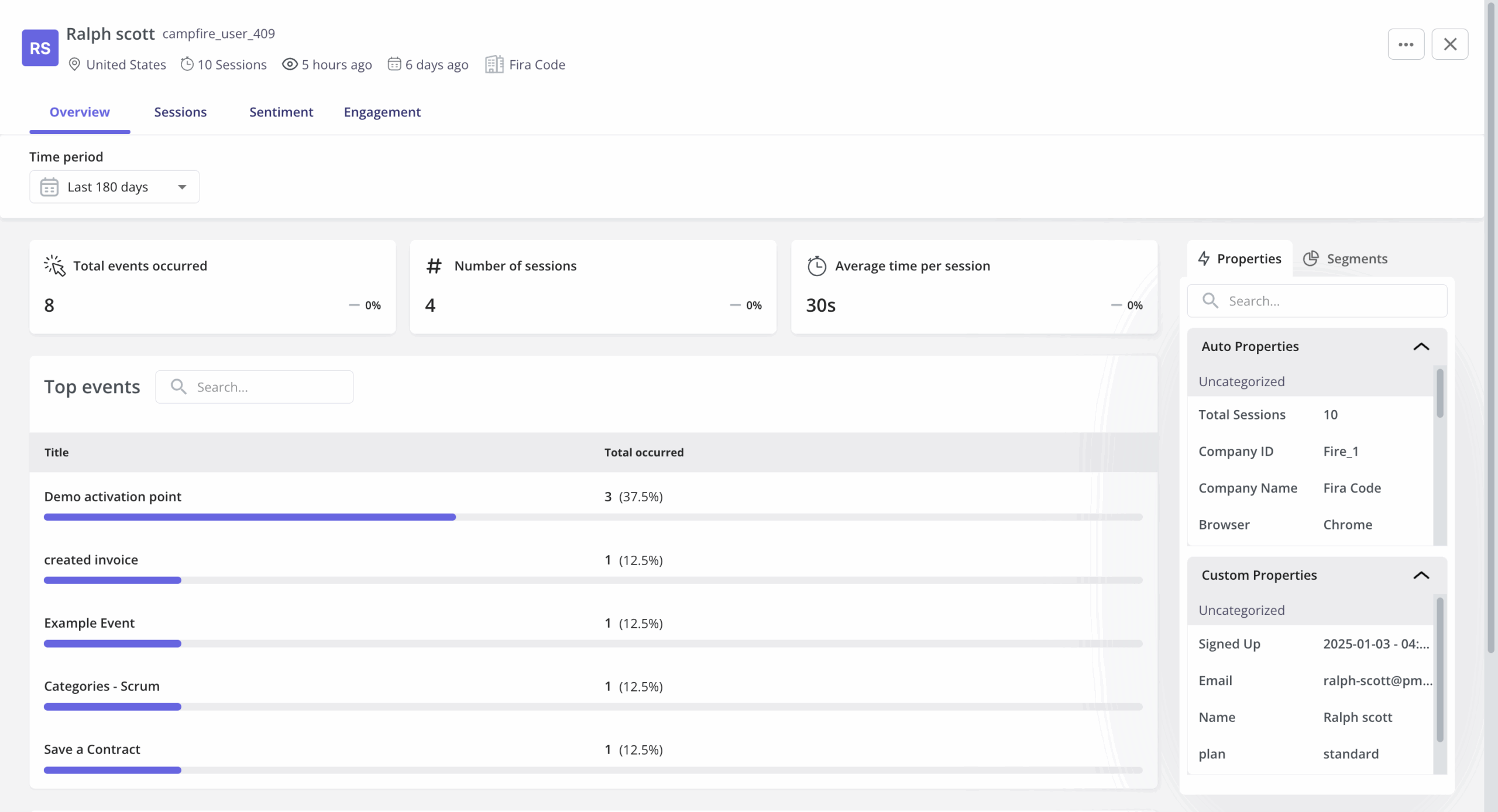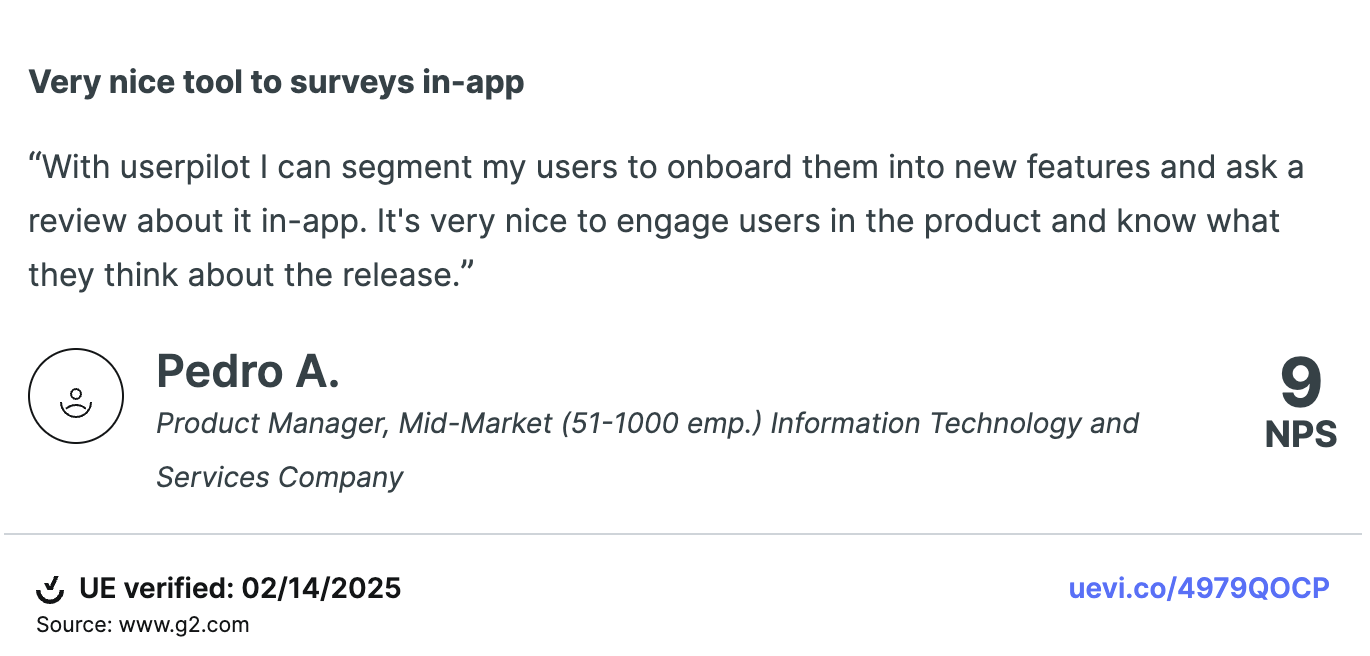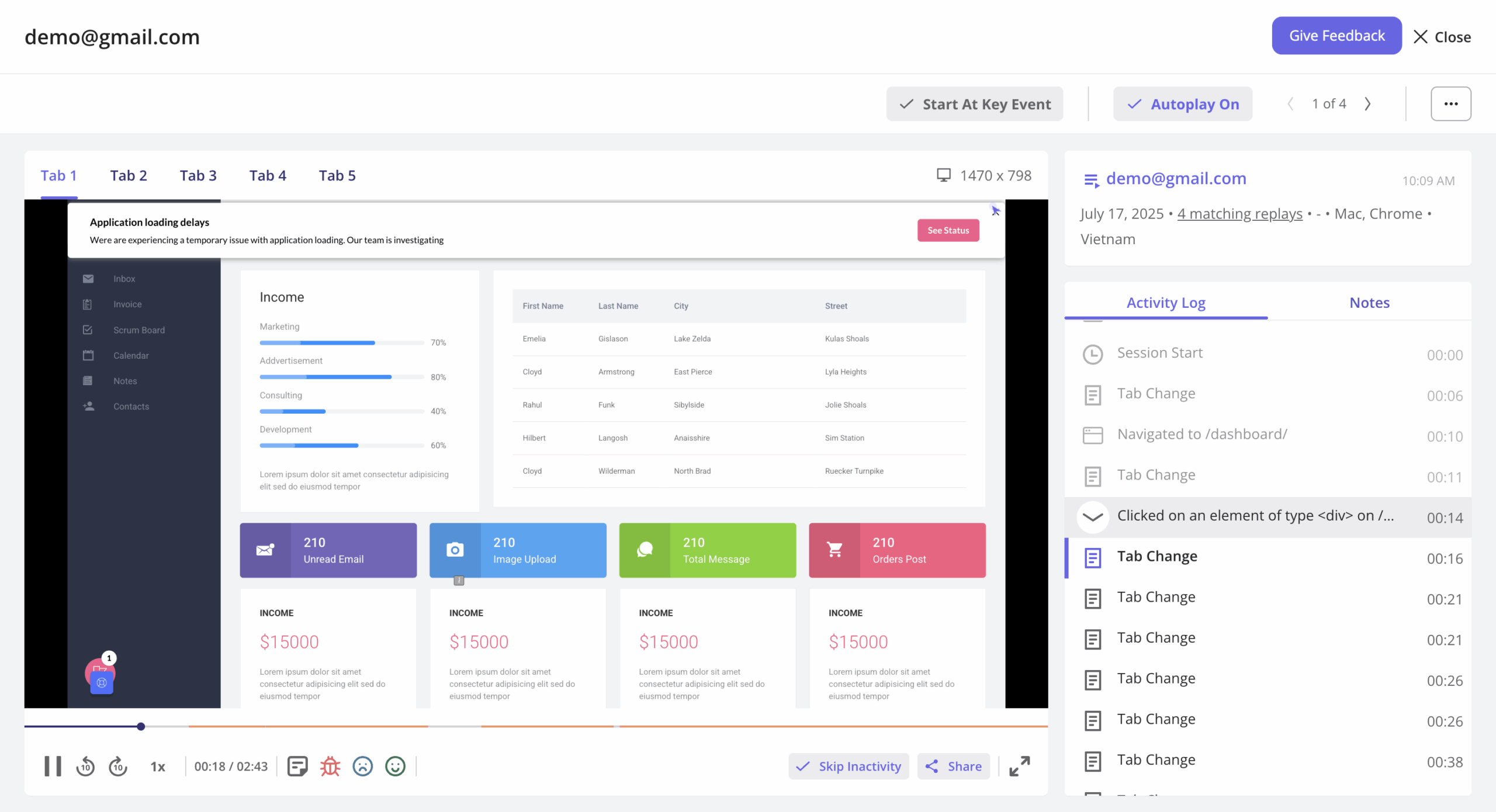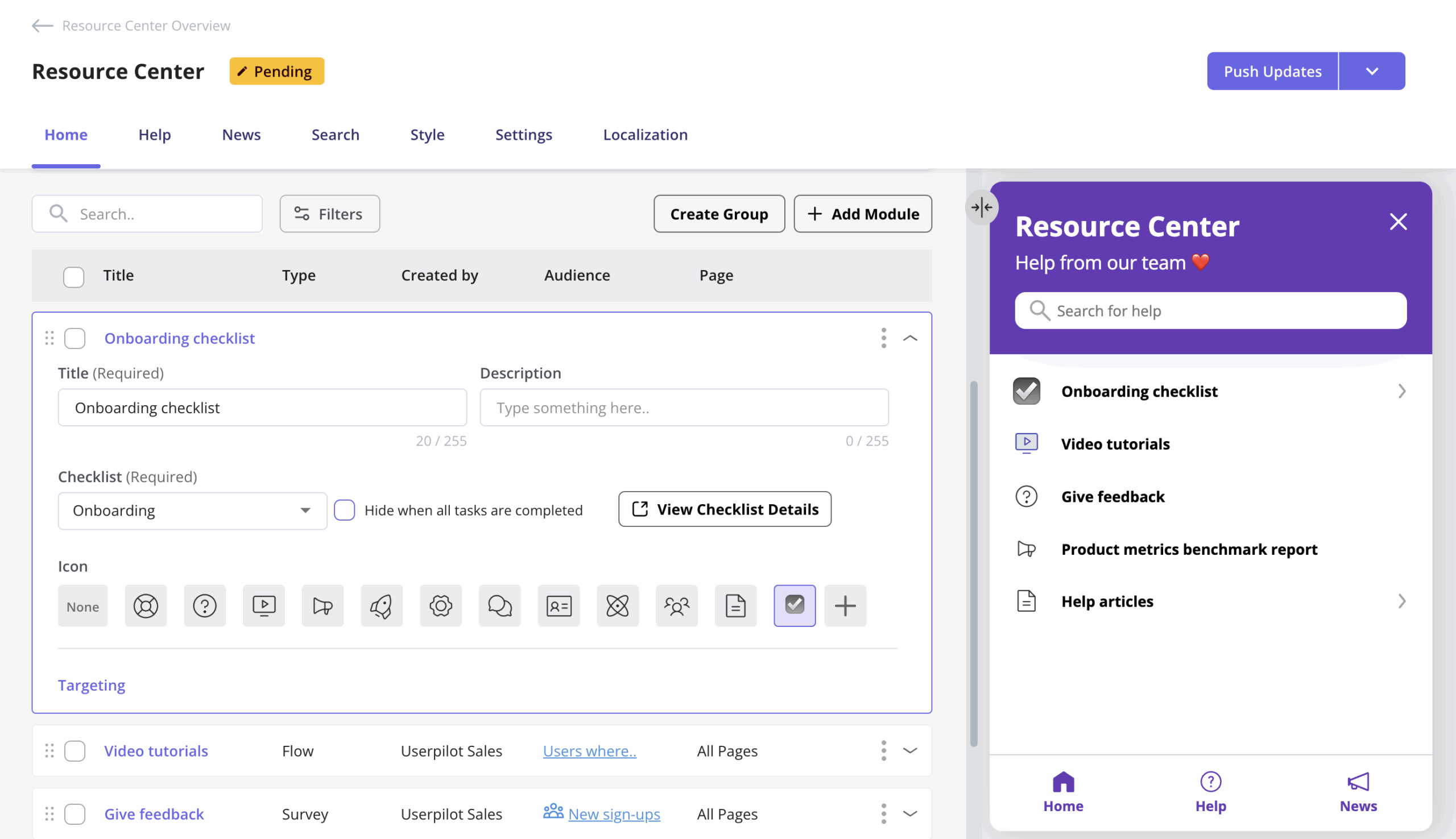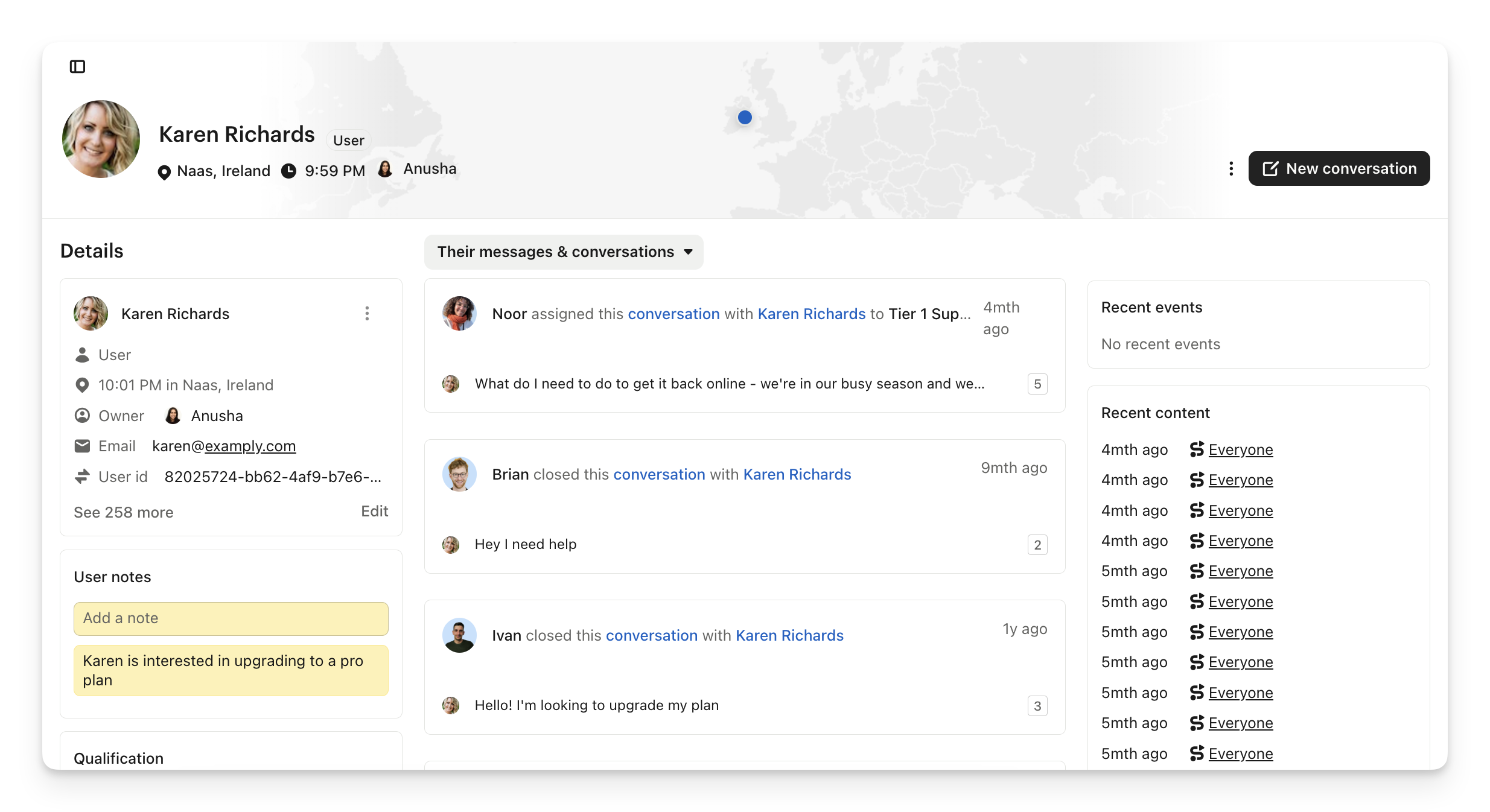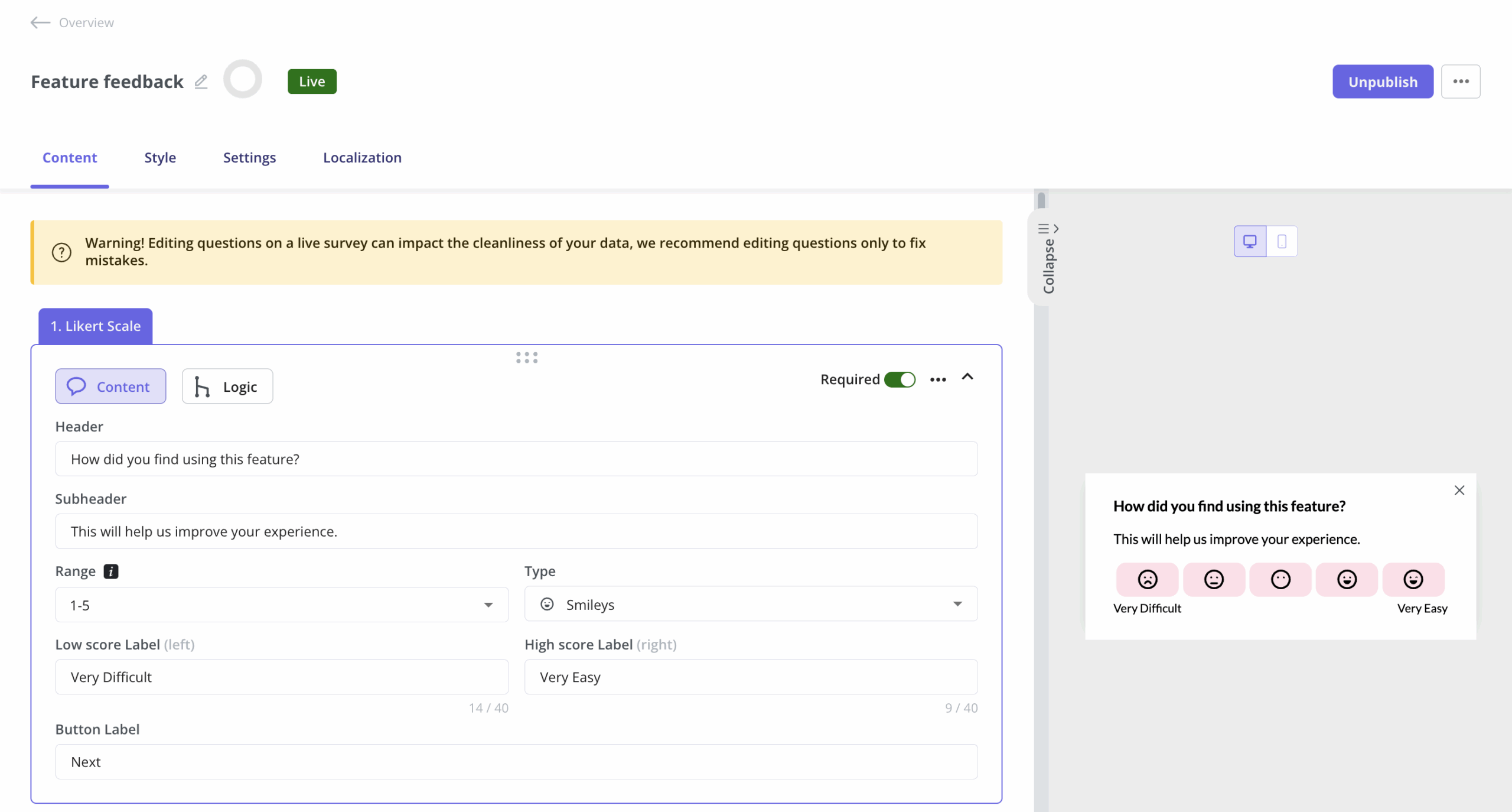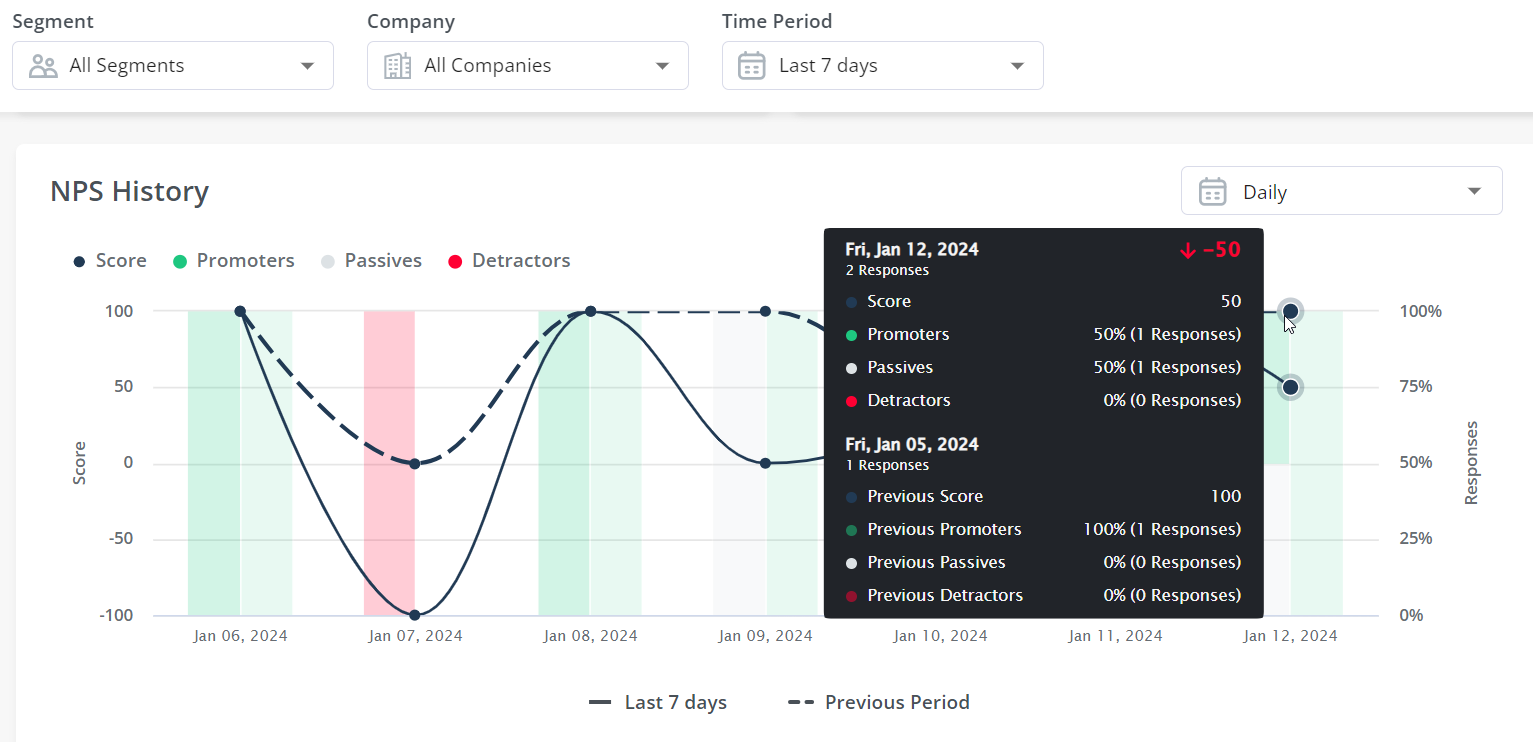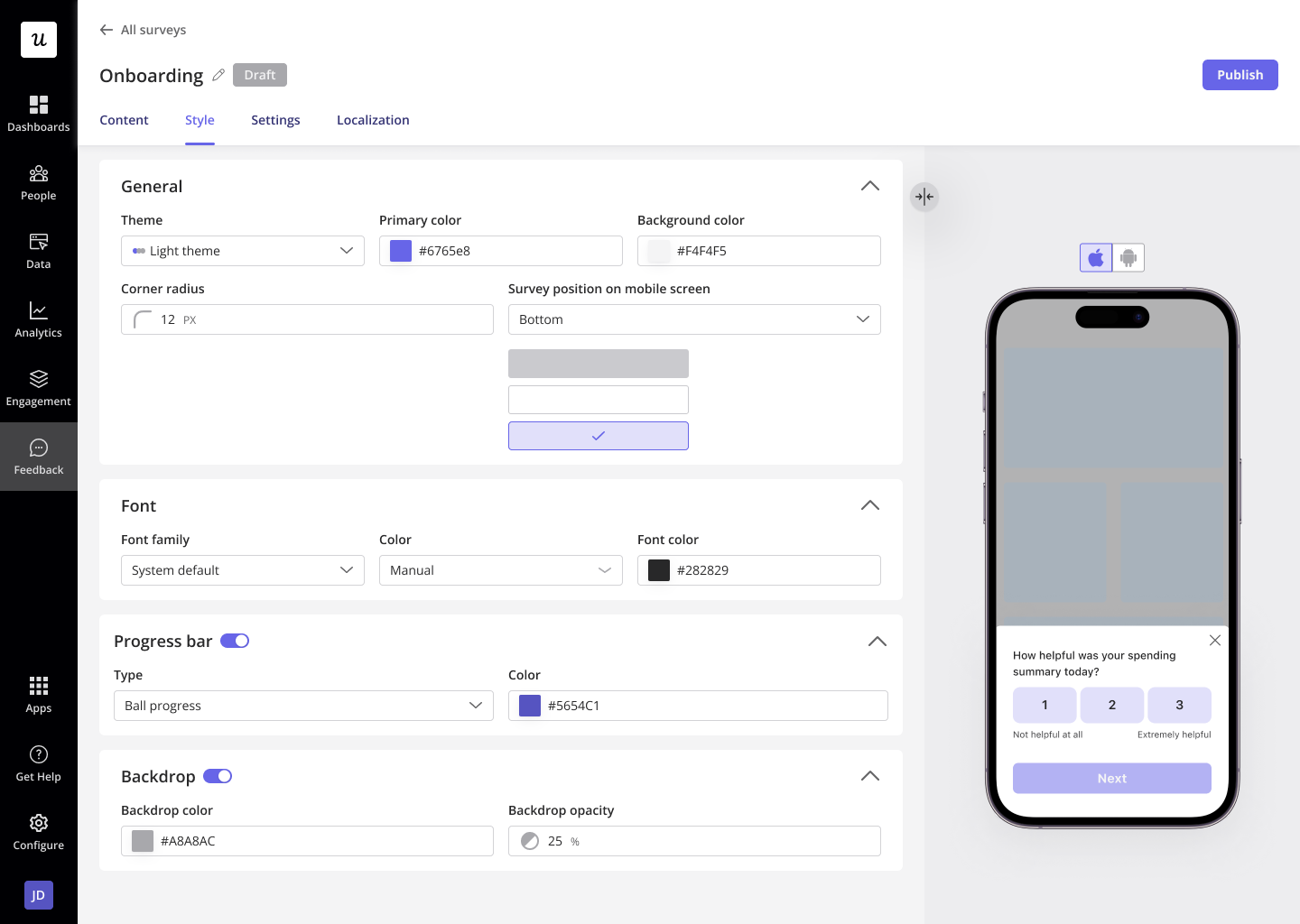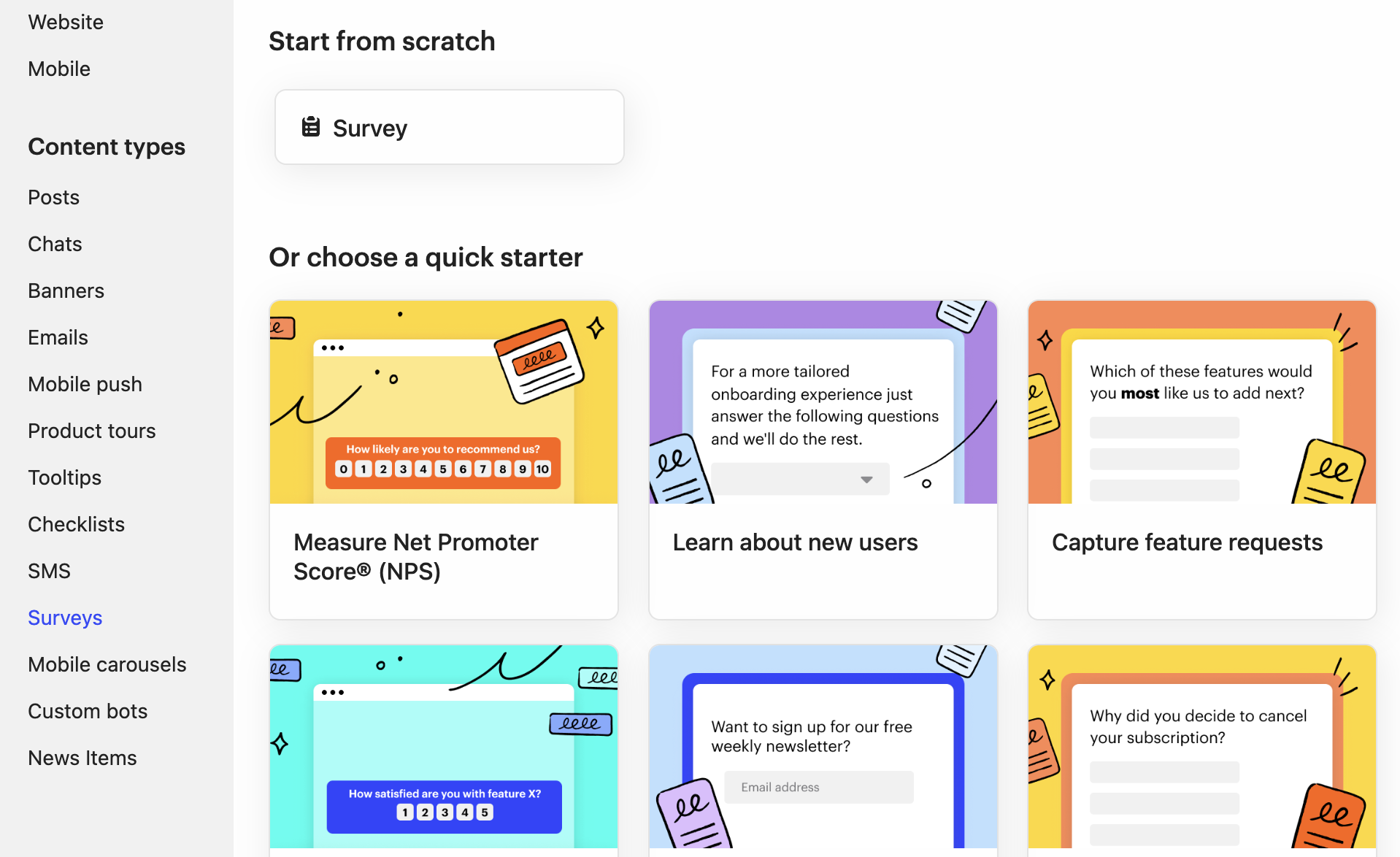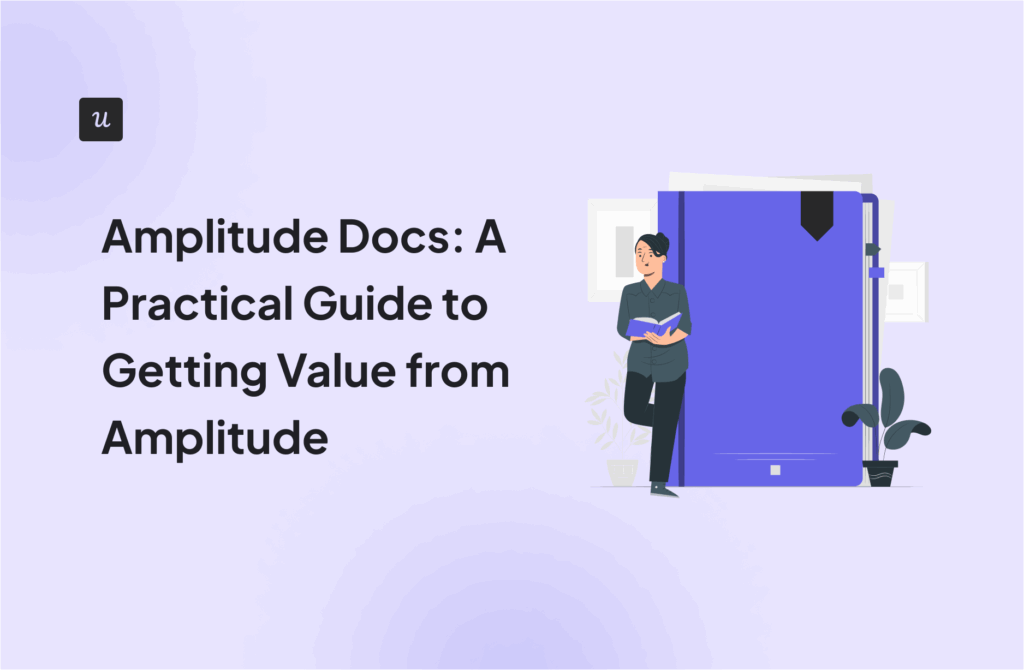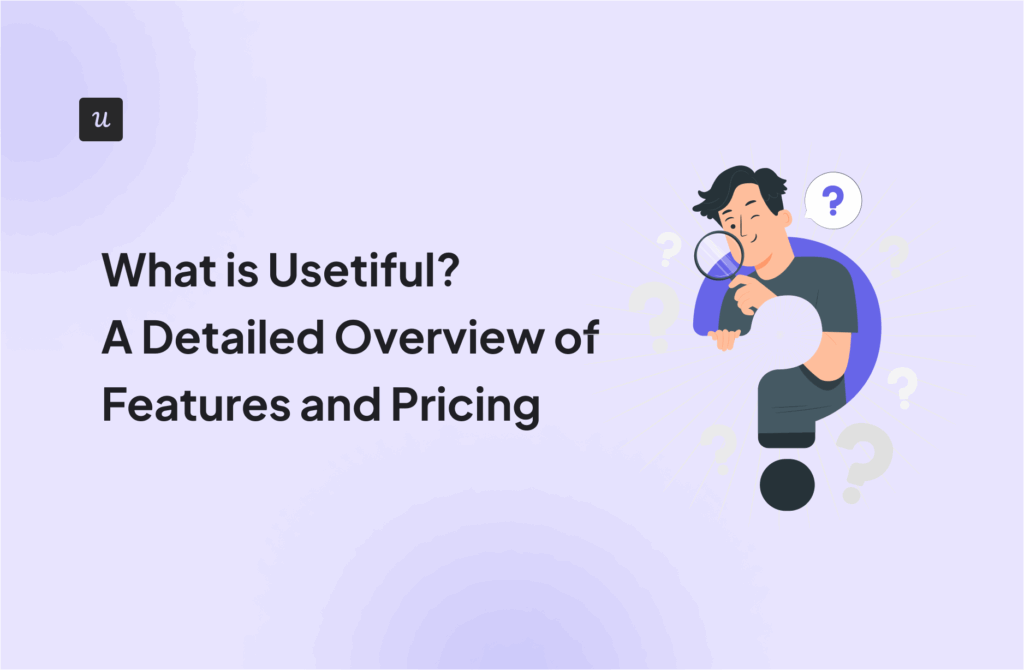
At Userpilot, I’ve talked to countless teams comparing us with Intercom, and it’s easy to get caught up in the promise of “better product engagement”. However, what matters is whether the tool fits your workflow.
Intercom started in customer support and live chat. They added product tours later as expensive add-ons that require developer setup and come with message limits. Product managers need something built for their workflow.
At Userpilot, we built every feature specifically for teams driving user onboarding and product growth without code. Our behavioral analytics and targeting work natively together, so you can see what users do and act on it immediately.
So here are the key differences to help you decide more easily.
Userpilot vs Intercom: What’s your primary goal right now?
Choose the one that matters most to your SaaS.
For your onboarding, how important is building code-free, interactive experiences?
Userpilot excels at no-code interactive walkthroughs, while Intercom’s product tours often require developer setup for event-based triggers.
Do you need deep product analytics to track feature adoption?
Userpilot includes built-in analytics like funnels, paths, and retention analysis. Intercom requires third-party tools for similar insights.
Is your main focus a support-centric tool with live chat and a shared inbox?
Intercom is a leader in customer support communication. Userpilot focuses on in-app guidance for product-led growth.
Based on your goals, Userpilot is the clear choice.
Userpilot is purpose-built for product teams to drive user activation and feature adoption without code. Unlike Intercom, which treats onboarding as a costly add-on, Userpilot provides a complete, cost-effective platform for product-led growth.
It looks like Userpilot is the best fit for your product team.
When comparing Userpilot vs Intercom, Userpilot gives product teams more power and flexibility. You get advanced analytics, deep segmentation, and true no-code control over the in-app experience to drive activation and adoption—all for a predictable price.
For a support-first strategy, Intercom is a strong contender.
Intercom excels at customer communication with its robust live chat and shared inbox. However, if your goals shift to product-led growth, feature adoption, or in-depth user analytics, consider how Userpilot’s all-in-one platform can provide better value without unpredictable costs.
You might be weighing your options between Userpilot vs Intercom.
While Intercom’s product tours can handle basic announcements, they lack the deep analytics and behavioral triggers needed for true product adoption. Userpilot provides a dedicated solution to not only announce features but also measure and drive their long-term usage, giving you a much clearer ROI.
Try Userpilot Now
See Why 1,000+ Teams Choose Userpilot

What is Userpilot?
We built Userpilot as a complete tool for teams who need to improve user activation and drive feature adoption without developers.
You can create user onboarding flows with interactive walkthroughs, tooltips, and surveys that guide users through key actions. When users complete these flows, they reach activation faster and stick around longer.
Our advanced analytics show exactly where users drop off. Track funnel performance, analyze user paths, and segment cohorts to understand what drives product adoption across your web app.
Userpilot integrations with Google Analytics, Segment, and Mixpanel give you unified data. Most users see better activation rates because everything connects in one platform, including Google Analytics data that syncs automatically.
What is Intercom?
Intercom is an AI-powered customer engagement platform built primarily for customer support teams. The platform emphasizes live chat, shared inboxes, and omnichannel communication across email, SMS, and WhatsApp.
For teams, Intercom offers user onboarding features through add-ons, creating complex pricing tiers. The Proactive Support Plus bundle costs $99/month for just 500 messages and includes product tours, surveys, and mobile carousels. Many other features that product managers need come with an additional cost.
Their product tours support user onboarding through tooltips, banners, modals, and checklists. You can track completion rates and segment audiences, but there’s a catch: event-based triggers require manual JavaScript setup. This means developer involvement for basic functionality that product teams expect to handle themselves.
Most users find the pricing structure limiting when scaling onboarding sequences beyond those 500 monthly messages.
When should you choose Userpilot over Intercom?
If you’re a product manager or growth team focused on driving onboarding, feature adoption, and product-led growth, Userpilot was built with you in mind. Here’s where we truly stand out from Intercom:
✅ You prioritize in-app training and product adoption
Userpilot gives you advanced onboarding capabilities with more control, better targeting, and zero developer reliance. You can A/B test flows, trigger content based on custom events, and personalize experiences by user segments. All without touching code.
“With Userpilot, the advantage we had was that we get to control more of the experience and how we display it with plenty more formatting options.”
— Gerard Masnou, Head of Support and Operations at Cledara
Take Cledara, for example. A SaaS management platform helping teams control software spend. They originally used high-touch onboarding and emails, but needed something more scalable and effective. After testing Intercom and finding it lacking in product marketing focus, they switched to Userpilot. Within just a week, their in-app messages drove more engagement than months of emails.
✅ You support product growth with data
Userpilot doesn’t just show flows, it helps you understand which flows actually work. Our built-in autocapture, session replay, and trend analytics let you:
- See what users do before/during/after onboarding.
- Spot friction points visually.
- Prioritize improvements based on real behavior.
Intercom, on the other hand, lacks this kind of behavioral product analytics. You’d need to integrate another tool (and pay more) just to see how users interact with your app.
✅ You want a more cost-effective solution
With Intercom, core onboarding tools are add-ons, specifically the Proactive Support Plus package, which costs $99/month for just 500 messages. If you’re trying to scale onboarding across thousands of users, that adds up quickly.
Userpilot starts at $299/month for 2,000 MAUs, so you don’t pay extra just to do onboarding right.
Userpilot vs Intercom for user onboarding
Intercom treats user onboarding features as add-ons to their customer support platform. We built Userpilot specifically to guide users through activation and create personalized onboarding sequences that customers can control.
Here’s how each platform handles user onboarding:
Userpilot for user onboarding
We built Userpilot so your team can control how new users experience your product from day one. No engineering required. Here’s what you can do:
✅ Build smart onboarding flows without code: You can use our Chrome extension to build and test onboarding sequences directly in your product. Your team can create branched experiences that adapt based on user actions. Perfect when your product serves multiple use cases or user types.
67% of SaaS tools don’t personalize the onboarding experience. With Userpilot’s customization options, you can make branching native so users get guided down different paths automatically.
✅ Customize every detail of your onboarding: You can choose from modals, tooltips, slideouts, and interactive walkthroughs. Your team can customize design, placement, animations, and triggers. You won’t get locked into rigid templates.
✅ Use tools that improve user activation: You can use checklists to guide users through key actions, launch NPS surveys to understand friction points, and create resource center articles for self-service help. Your users will move from signup to activation faster.
✅ Target users precisely without developers: You can target users by page, feature interaction, subscription plan, or custom properties using “and/or” logic. Your team can track everything natively, while other platforms like Intercom require JavaScript setup.
✅ Get analytics built into every flow: You can track completion rates, analyze drop-off points, and segment performance data. Your team won’t need third-party integrations.
“The engagement part in Userpilot has been the easiest for us to make a difference because then we can understand if our users understand better what they’re supposed to do. We have a few flows that we’ve tried, and we also do release notes now with the modal, which is really good, and then we can see how many click the actual release notes or not.”
— Isa Olsson, UX Researcher at Zoezi
✅ Deliver onboarding across web and mobile: You can deliver consistent user onboarding across your web and mobile app with the same targeting rules.
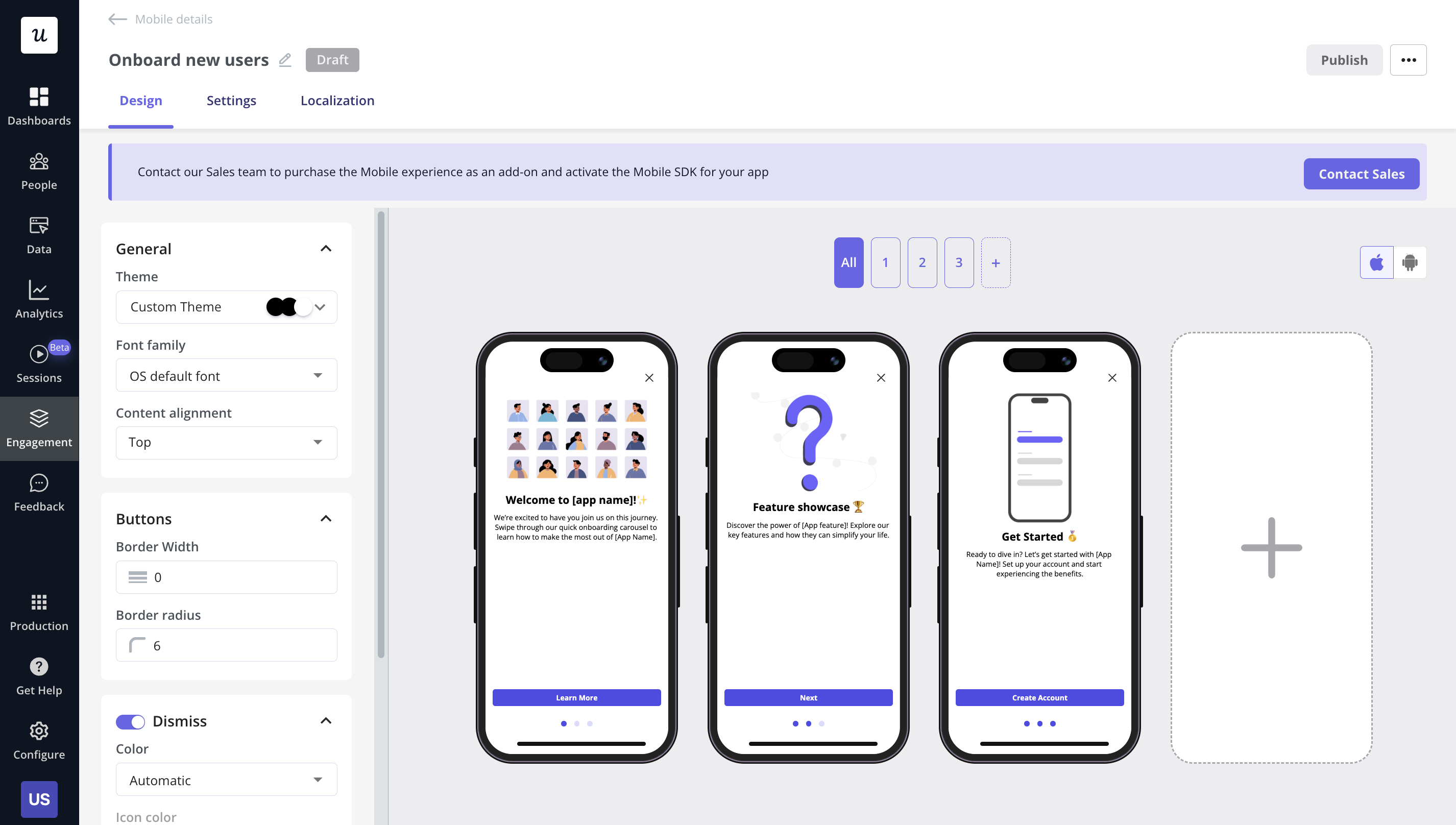
Intercom for user onboarding
Intercom positions itself as a customer support platform first. You can access user onboarding features through their Product Tours add-on, but these are layered on top of their core messaging and support tools.
✅ UI patterns through paid add-on: You can get modals, tooltips, banners, and checklists with the Product Tours add-on ($99/month). Your team can also deliver SMS or live chat within the same user journey.
✅ Basic audience targeting: You can segment audiences using AND/OR rules, filtering by user attributes or past behavior. Your team can target company-level groups for broader campaigns.
⚠️ Requires developer setup: You cannot trigger tours based on user behavior without custom JavaScript or SDK setup. Your team will need engineering support or tag management tools, unlike platforms built for no-code use.
✅ Analytics included in add-on: You can track views, completions, and drop-off counts for each tour. This data helps you understand tour effectiveness.
⚠️ Message limits increase cost: You get 500 outbound messages included, but additional messages have pricing at $0.07 to $0.025 each. If your team needs to guide thousands of users through user onboarding, costs can grow quickly compared to transparent MAU-based pricing.
⚠️ Limited API capabilities: You cannot detect when tours start or end programmatically. This makes advanced analytics or custom integrations harder to implement.
Userpilot vs Intercom for product adoption
When you compare Userpilot and Intercom for product adoption, you’ll see which tool fits your needs better based on depth, flexibility, and analytics capabilities.
Userpilot for product adoption
Product adoption is an ongoing process. We give your team the visibility and tools to guide users from first interaction to full adoption using real-time data.
✅ Autocapture every user interaction without developers: You can automatically track clicks, hovers, and inputs across your product. Your team can tag features, measure usage, and trigger flows without engineering help.
✅ Visualize adoption with advanced analytics: Your team can:
- See the best features driving long-term engagement.
- Identify drop-off points in adoption funnels.
- Track retention cohorts by segment.
- Analyze trends over time across many features.
✅ Track everything in one dashboard: You can get a real-time overview of DAUs, MAUs, session duration, and feature usage, plus a comprehensive overview of user behavior patterns without doing it manually or paying extra.
✅ Drive adoption across web and mobile: You can guide users contextually across channels. Your team can launch nudges, announcements, or user onboarding based on behavior using the same targeting engine.
✅ Capture user feedback: You can launch CSAT, CES, and NPS surveys in-app using customizable templates or build custom feedback flows. This helps you understand how users perceive the best features.
✅ Analyze adoption by user and company: You can drill into activity by user, segment, or company to understand which groups adopt new features and which need a nudge. Your team can adjust messaging dynamically based on these insights.
Intercom for product adoption
In my experience, Intercom isn’t a dedicated product adoption tool, but it does offer a few capabilities that can support ongoing engagement. These are mostly extensions of its support and messaging platform.
✅ In-app messages for feature promotion: You can use outbound messages (modals, banners, tooltips) to introduce new features or prompt users to upgrade. However, you’re restricted by monthly message quotas and will pay more if you exceed them.
✅ Web-based Help Center only: You can create a customizable Help Center where users browse support content. However, users must leave your app to access help, which can disrupt adoption flows. The analytics show basic views and ratings, but don’t connect to feature usage data.
⚠️ Basic surveys with limited targeting: You can create NPS surveys and in-app questionnaires using their Surveys tool. However, customization and targeting are limited unless you combine them with event tracking, which requires JavaScript implementation.
⚠️ Only basic tour analytics without advanced capabilities for product adoption: You cannot get product usage analytics out of the box. Your team will need integrations with third-party tools like Mixpanel or Amplitude to track how users actually adopt features.
Userpilot vs Intercom for customer experience
Customer experience comes from proactive guidance, friction resolution, and value delivery across each user interaction. Here’s how we help you shape the customer journey compared to Intercom’s support-focused approach:
Userpilot for customer experience
Great customer experience starts with understanding your users. We give your team tools to analyze behavior, gather feedback, and create in-app experiences that reduce friction.
✅ Detailed user and company profiles: You can drill into any user or company to see past sessions, feature usage, survey responses, and engagement data. Your team can identify high-value accounts or spot drop-off signals early.
✅ Contextual in-app surveys: You can collect direct customer feedback with CSAT, CES, or custom surveys. Your team can trigger them based on user behavior, lifecycle stage, or role.
✅ NPS dashboard with trend analysis: You can track customer loyalty over time, segment NPS scores by user or company attributes, and analyze open-ended responses to uncover improvement opportunities.
✅ Session replays to spot friction: You can watch real user sessions to understand exactly where users struggle. Your team can combine this data with survey results or customer support tickets for complete context.
✅ Customizable in-app resource centers: You can deliver better support inside your product. Your resource centers can include videos, help docs, walkthroughs, or release notes tailored by segment or page.
Intercom for customer experience
We know Intercom offers several best features designed to improve customer experience, though they’re built around its support-first approach:
✅ Support conversation analytics: You can get detailed reporting on support interactions, including response times and satisfaction ratings based on customer feedback.
✅ Surveys require paid add-on: You can deploy CSAT, CES, and NPS surveys in-app, via email, or chat. However, surveys have restricted targeting options and require a separate $49/month subscription.
✅ Help Center with basic analytics: You can create a multilingual knowledge base accessible through chat search. It tracks article views and how users respond to bot interactions, helping you spot common issues and improve how teams respond to customer needs.
✅ Basic user and company profiles: You can access built-in user and company views showing activity, conversation history, and survey responses. You can segment using AND/OR logic based on user attributes.
✅ Outbound messaging with message limits: You can send targeted in-app posts and push notifications with the Proactive Support Plus add-on ($99/month for 500 messages).
⚠️ Limitations for product teams: Intercom’s customer experience features center on live chat and support analytics. You cannot access advanced analytics like session replay, autocapture, or funnel visualization. Their resource library requires users to leave your product to access help content.
Userpilot vs Intercom for user feedback
We know that collecting the right user feedback at the right time helps you improve your product based on real user needs. Here’s how Userpilot and Intercom differ in feedback collection, from survey types to targeting and actionability.
Userpilot for user feedback
We built our feedback system to be timely, contextual, and actionable. Your team can collect user feedback across web and mobile without code.
✅ No-code survey builder with flexible targeting: You can build and trigger surveys without writing code. Your team can customize content, placement, and behavior to match your product’s design and deliver feedback prompts when users are most engaged.
✅ 14 Survey templates for every goal: You can choose from templates designed for feature research, user onboarding improvement, CSAT, CES, NPS surveys, and more. Your team gets both quantitative benchmarks and qualitative insights.
✅ Survey analytics with clear patterns: You can analyze results by segment, spot common responses, and track changes over time. Open-text feedback gets categorized automatically to help you review patterns and where to take action.
“We always wanted a structured way of understanding what users like and don’t like. With Userpilot, we’ve seen people interacting with the product more and using more features.” — Ankit Mehta, Product Manager at Unolo
✅ Centralized NPS dashboard: You can get a unified view of all NPS campaigns. Your team can filter by segment, track score changes over time, and monitor response rates from one place.
✅ Collect feedback on mobile too: You can collect feedback inside your mobile app using the same triggers and logic as your web app. Perfect for consistent feedback collection across platforms.
Intercom for user feedback
Intercom offers basic survey capabilities for user feedback collection, but with limited flexibility and targeting compared to dedicated feedback tools.
✅ Two survey formats with limited customization: You can choose between small banner surveys for quick ratings or large modal surveys with up to 15 questions. However, customization options are limited compared to specialized survey tools.
✅ Basic analytics and response tracking: You can monitor survey delivery, response rates, and click-through rates. Your team can map answers to user attributes for segmentation, but this requires manual setup and lacks visual analysis.
✅ Limited targeting requires developer support: You can target surveys using basic filters. However, event-based triggering requires custom JavaScript, meaning you cannot launch surveys based on in-app behavior without developer support.
💰 Survey add-on required: You can create surveys on the Starter Plan, but publishing requires a separate $49/month subscription in addition to your core Intercom cost.
Userpilot vs Intercom: Pros and cons
Each platform serves different needs. Your choice depends on whether you prioritize product growth or customer support. We’ll break down the core pros and cons of Userpilot and Intercom to help you weigh functionality, flexibility, and overall value.
Pros of Userpilot
✅ Faster time-to-value without engineering bottlenecks: Your product team can build user onboarding sequences, launch NPS surveys, and track feature adoption without waiting for developer resources. This means you can test ideas, iterate quickly, and improve user activation within days, not sprints.
✅ All analytics and engagement tools in one platform: You get native behavioral analytics, segmentation, and user engagement tools that work together. Instead of managing separate subscriptions for analytics, surveys, and user onboarding tools, your team can analyze user behavior and act on it from the same dashboard.
✅ Predictable costs that scale with your business: Pay per monthly active user, not per message or feature. As your product grows, you won’t face surprise bills or usage caps that limit how you guide users through your app.
✅ Advanced targeting without technical complexity: Your team can trigger experiences based on user behavior, subscription plan, or custom properties using visual rules. No JavaScript required, so marketers and PMs can create sophisticated user journeys independently.
Cons of Userpilot
❌ Higher upfront cost for early-stage teams: The starter plan costs $299/month billed annually ($299/month billed monthly) with no free tier. Small teams with tight budgets might need to justify this investment before seeing user activation improvements.
❌ Primarily customer-focused: While the technology could work for employee onboarding, Userpilot lacks HR-specific features like compliance tracking and internal training workflows that dedicated employee onboarding elements provide.
Pros of Intercom
✅ Proven customer support efficiency at scale: Your support team can handle higher ticket volumes through AI automation and unified inbox management. Fin AI resolves 60%+ of routine queries automatically, letting human agents focus on complex issues that drive customer satisfaction.
✅ Quick implementation for support-focused teams: Your team can get live chat and help desk functionality running quickly with minimal setup. The intuitive interface means faster team adoption and less training overhead.
✅ Comprehensive communication platform: You can manage customer conversations across web, mobile, email, SMS, and social media from one dashboard. This reduces context switching and improves response times for support teams.
✅ Strong integration ecosystem: You can connect with 300+ tools in your existing workflow, from CRM to analytics platforms. This helps maintain data consistency across your customer communication stack.
Cons of Intercom
❌ Unpredictable costs hurt budget planning: Essential features like surveys ($49/month), product tours ($99/month), and mobile messaging come as separate add-ons. Your monthly costs can double or triple as you scale user engagement, making budget forecasting difficult.
❌ Limited product adoption insights affect strategy: You cannot get behavioral analytics like user funnels, session replays, or feature adoption tracking. This means your teams need separate tools to understand how users actually interact with your product.
❌ Message quotas limit growth initiatives: Mobile messaging caps at 500 messages/month on standard plans. If your team’s growth plan requires guiding thousands of users through onboarding or feature launches, you’ll hit usage limits quickly.
❌ Support-first approach doesn’t fit product workflows: Built for reactive customer support rather than proactive user engagement. Product managers often struggle to create the guided experiences that drive feature adoption and user activation.
Userpilot vs Intercom – Why Userpilot might be a better choice?
Userpilot is purpose-built for product teams. Unlike Intercom, which is rooted in customer support, Userpilot focuses entirely on user onboarding, feature adoption, and product analytics, all without requiring a single line of code.
- Drive user activation faster: Your team can build onboarding flows with modals, tooltips, and interactive walkthroughs using our Chrome extension. You get all UI patterns on the Starter Plan and can trigger experiences with behavioral rules.
- Measure feature adoption automatically: You can track feature usage through autocapture, analyze user paths with advanced analytics, and spot drop-off points in real-time dashboards. Your team can then nudge users toward underused features. Intercom requires separate tools and developer setup.
- Get behavioral analytics in one platform: You can run funnel, path, and retention reports to see exactly where users struggle. Built-in NPS surveys and 14 survey templates help you understand why users drop off and what drives activation.
If you’re a product-led team that cares about activation and product growth, Userpilot gives you better value for money and the depth and flexibility Intercom simply wasn’t built for.
Ready to choose the right platform for your product team?
When you compare Userpilot against Intercom, both bring strengths to the table. But they’re built for different teams and goals. Intercom excels at live chat and customer support automation. Userpilot was purpose-built for teams that want to drive user onboarding, feature adoption, and product-led growth.
If you’re a mid-market SaaS looking for better value, deeper insights, and true no-code control over the in-app experience, Userpilot is the smarter long-term choice for your product team.
See how Userpilot can boost your activation and adoption goals, book a demo today!

